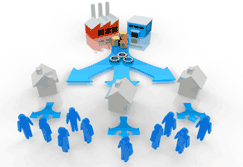When the coronavirus first emerge in China, the supply chain focus was on the supply side, as thousands of Chinese factory closed, workers were slow coming back after the China's New Year's celebrations in January, and port activity for exports slowed dramatically.
In the US the focus has now shifted dramatically to the demand side impact, as almost everything outside of food and related consumer packaged goods is seeing huge drops in demand, starting with forced store closures of most department and specialty stores, then what is sure to be a big drop in in demand for many industrial products, a huge fall in automobile sales and much more.
Supply Chain Digest Says... |
 |
| "It only makes sense that firms should incorporate disruption-related metrics in their evaluations of suppliers," the trio argues. |
 |
What do you say? |
| Click here to send us your comments |
 |
| Click here to see reader feedback |
|
|
But as companies grapple with how hard and how long demand will fall, it is important for companies to not forget about the lessons on the supply side. Notably, another tough lesson, as with the 2011 earthquake and tsunami in Japan, on the need to map a company's multi-echelon supply chain.
So say Dr. Thomas Choi, Dr. Dale Rogers and Bindiya Vakil in a recent article in the Harvard Business Review on-line. Choi and Rogers are at Arizona State University, while Vakil is CEO of Resilinc, a supply chain risk management services provider.
Most firms do not well map their full supply chains, the trio say.
However, "A small minority of companies that invested in mapping their supply networks before the pandemic emerged better prepared" Choi, Rogers and Valik say. "They have better visibility into the structure of their supply chains. Instead of scrambling at the last minute, they have a lot of information at their fingertips within minutes of a potential disruption. They know exactly which suppliers, sites, parts, and products are at risk, which allows them to put themselves first in line to secure constrained inventory and capacity at alternate sites."
That does sound like a lot better place to be. If the benefits are so strong, why don't more companies do it?
The simple answer is that the process is hard, takes a long time, and is potentially expensive. Add to that disruptions of a huge magnitude where the map is really needed are arguably relative rare.
Executives of a Japanese semiconductor manufacturer told the authors that it took a team of 100 people more than a year to map the company's supply networks deep into the sub-tiers following the earthquake and tsunami in 2011. That is a very expensive effort.
"Yes, supply network mapping can be resource intensive and difficult. However, there is no way around it," the authors say, adding that "Companies will discover the value of the map is greater than the cost and time to develop it."
How is such a mapping effort performed?
The authors say the most common approach is to use the bill of materials and focus first on key components, perhaps involving the top five products by revenue and then drilling down to their component suppliers – and ideally to their suppliers as well, all the way down to raw materials vendors.
(See More Below)
|
CATEGORY SPONSOR: SOFTEON |
|
|
| |
|
|
The goal, they say, should be to go down as many tiers as possible, because there may be hidden critical suppliers the buying firm is not aware of. The map should also include information about which activities a primary site performs, the alternate sites the supplier has that could perform the same activity, and how long it would take the supplier to begin shipping from the alternate site – if, SCDigest notes, they have the extra capacity.
 An issue, the authors say, is the way the procurement function is typically measured – typically around cost savings in procured components and materials. An issue, the authors say, is the way the procurement function is typically measured – typically around cost savings in procured components and materials.
"It only makes sense that firms should incorporate disruption-related metrics in their evaluations of suppliers," the trio argues.
For example, when selecting a supplier and writing the initial contract, many leading companies include language that requires the supplier to participate annually in its supply-chain mapping efforts. When force majeure events like the current pandemic strike, those supply maps can be used as a roadmap to solutions to the crisis.
"After the Covid-19 crisis dissipates, we will see companies fall into one of two categories. There will be those that don't do anything, hoping such a disruption won't ever happen again. These companies will be taking a highly risky gamble,t" Choi, Rogers and Valik conclude, adding that "There will [also] be firms that heed the lessons of this crisis and make investments in mapping their supply networks so they do not have to operate blind when the next crisis strikes and rewrite their contracts so they can quickly figure out solutions when disruptions occur."
These companies will be the winners in the long term, they say.
The full article is available here: Coronavirus Is a Wake-Up Call for Supply Chain Management
Is such detailed supplier mapping worth the effort? Let us know your thoughts at the Feedback section below.
Your Comments/Feedback
|